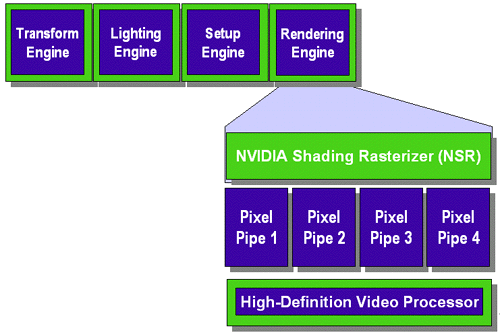The GeForce 2 GTS is a 0.18-micron version of the original GeForce. It still features 4 rendering pipelines, a.k.a. the GeForce’s QuadPipe Rendering Engine, but unlike the original GeForce, the GeForce 2 GTS is capable of processing two textures per pipeline in a single clock versus the one texture per pipeline on the original GeForce. This translates into rendering power equivalent to twice that of the GeForce at the same clock speed.

Since the GeForce 2 GTS received a die shrink down to a 0.18-micron process, NVIDIA was also able to increase the core clock speed of the solution from the 120MHz of the 0.22-micron GeForce up to 200MHz of the GeForce 2 GTS. Even the most insane overclockers couldn’t get their GeForces up beyond 170MHz, so hitting 200MHz on this 0.18-micron process is definitely an improvement over the original GeForce.
Combining these two bits of information, we get a pixel fill rate of 800 megapixels per second for the GeForce 2 GTS, which is up from 480 megapixels per second for the GeForce, and we get a texel fill rate of 1600 megatexels per second or 1.6 gigatexels per second, which is where part of the GTS acronym comes from – Giga Texel Shader.

Until 3dfx officially releases the Voodoo5 6000 (which will be after the GeForce 2 GTS hits store shelves), NVIDIA will have the highest pixel and texel fill rates in the industry, even outweighing those of the Voodoo5 5500, which currently boasts a 667 megapixels & 667 megatexels per second fill rate.
Even the ATI Radeon 256, which we just recently previewed, won’t be able to compete with the GeForce 2 GTS in terms of raw fill rate power as its specs at a 200MHz core clock speed yield a 400 megapixels per second and 1.5 gigatexels per second fill rate.
Only the Voodoo5 6000, which should debut at close to twice the cost of the GeForce 2 GTS, will be able to offer a superior fill rate of 1.33 gigapixels/s and 1.33 gigatexels/s.
If that were the only improvement NVIDIA offered over the original GeForce, they would already have a very powerful product, but fortunately for the sake of competition and furthering the industry, they have much more to offer from this chip.










4 Comments
View All Comments